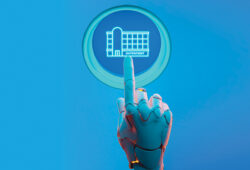Medical devices & drugs require careful assessment of need & cost
There’s never been a more exciting time to work in healthcare, as we adopt important surgical and pharmaceutical advances that will change care delivery forever. Healthcare leaders must stay aware of these changes and diligently consider both the clinical need and financial stewardship when making purchasing decisions.
Building better robots
The robotics market has essentially doubled in the last five years. Physician preference is primarily driving the market explosion, as robotic device manufacturers create better surgical approaches. The difficulty is balancing the cost of the new products with better patient outcomes and care quality.

“Robotic devices add cost to a surgical case, and there needs to be a reason to justify the added cost, whether it’s a clinical benefit, overall financial benefit or all of the above,” says Fred Keller, VP of Custom Contracting at HealthTrust. “If you’re just adopting robotics and not paying attention to the incremental benefit, then you may just be adding cost.” In other words, purchasing decisions must go beyond physician preference and the desire to have the latest technology, so robotic devices don’t just collect dust in hospitals instead of benefitting patients.
The robotics field will continue to advance as other innovations enable them. “Believe it or not, the 5G cellular network that we’re clamoring for has applications in robotics as well,” says Keller. The technology could potentially allow surgeons to perform a robot-assisted surgery remotely—as in, from another state or even from a different country. And in the not-too-distant future, robots will evolve to allow for more clinical applications across multiple modalities for use in cancer treatment, urological cases and more complex surgical cases. “Robots will continue to advance and hopefully be utilized in the right way, producing a clinical benefit for both physicians and patients.”
Minimally invasive aortic valve replacement surgery
Twenty years ago, if a patient needed to have an aortic heart valve replaced, a surgeon would perform an invasive open-heart surgery that involved opening the chest, cracking the sternum, replacing the valve and then wiring the sternum back together. “The sternum soreness outweighs the heart procedure,” explains Keller. While it is widely considered a safe and effective procedure, some patients aren’t good candidates for this surgery for reasons including advanced age and other comorbidities.
In 2002, a device technology called TAVR (transcatheter aortic valve replacement) came along. TAVR allows doctors to use a catheter to intravenously insert a replacement valve without removing the old valve. The procedure is minimally invasive, so the sternum isn’t opened. TAVR also has an embolic protection component that catches any loose plaque with a wire net and removes it after the procedure is complete, which protects against stroke.
“It’s important for hospital leaders to know that over time, as more doctors adopt the TAVR technology, it will add to the cost of the procedure,” says Keller. On the other hand, reducing the risk of stroke also has a cost benefit, so TAVR may be the right financial decision, since it presents a potentially life-extending surgical option for a subset of patients who have fewer options for treatment.
A cure for hypertension?
Medtronic’s Symplicity Spyral renal denervation system is in clinical trial and on its way to reaching clearance from the U.S. Food and Drug Administration (FDA). “The catheter system essentially provides the opportunity to cure people who have hypertension,” explains Keller. Since nearly half of Americans have hypertension, the technology could qualify as a game changer. “The catch is that we won’t know what it will cost until after it’s FDA approved,” he adds.
People with hypertension have high blood pressure, which means that blood is pumping hard on artery walls as arteries carry blood from the heart to the rest of the body. High blood pressure can lead to stroke, heart attack, kidney failure and other life-threatening conditions. Treatment for hypertension includes lifestyle changes and medication such as diuretics, beta blockers and ace inhibitors. With renal denervation, a doctor inserts a catheter into the arteries leading to the kidneys, which helps regulate blood pressure. Renal denervation delivers energy to the overactive nerves to lower their activity, which lowers blood pressure.
“This promising procedure truly creates a new approach to treat high blood pressure,” says Keller. “And while it all sounds great, we won’t know how the cost of providing this technology will affect hospitals.” If it helps patients, hospitals will find a way to provide it when the time comes, but they’ll want to be cognizant of balancing innovation with financial stewardship for the greater good.
New era in pharmaceuticals
Medicine is moving in a much more personalized, preventive and curative direction. “With today’s drugs, we’re only addressing about 20% of what ails people,” says Keller. To get at the other 80%, pharmaceuticals must approach the way they work differently, and that is starting to happen. Case in point: “Today, an infant can be diagnosed with spinal muscular dystrophy and take a bunch of medications. Or they can take one drug called Zolgensma for $2 million, and the child won’t get the disease.” The infusion therapy that came out in 2019 addresses the disease’s root cause by replacing a missing gene.
Similarly, the mRNA vaccine technology teaches our cells how to make a protein that triggers an immune response in our bodies. This advancement is precisely what has allowed us to make progress during the pandemic.
Keller says that more drugs will be made in this manner, where your doctor will do a blood test and, in a matter of a day, have a good understanding of what diseases you have or will have in the future, and what to do about it. Technology and tools will make it so that we can sequence DNA in a matter of minutes and deliver answers to many questions. “This is coming within the next 50 years, and it raises a lot of ethical questions,” he says. “Just because we can fix someone, should we?”
It’s exciting for younger generations, especially, to fathom how advances in healthcare might make it possible for us to live well past 100 years. The key will be figuring out how to apply innovation in a responsible, sustainable way. Keller adds: “Facilities and providers need to have resources that are helping them manage this balance on a daily basis.”
Read more on medical device management.
Share Email Drugs, Medical Devices, Q2 2022





